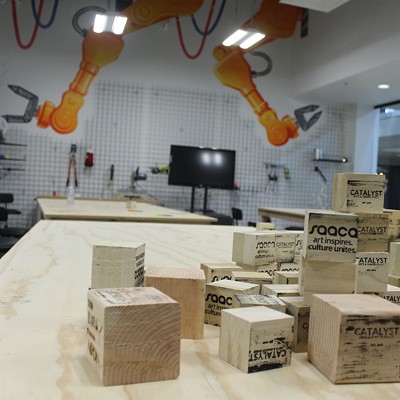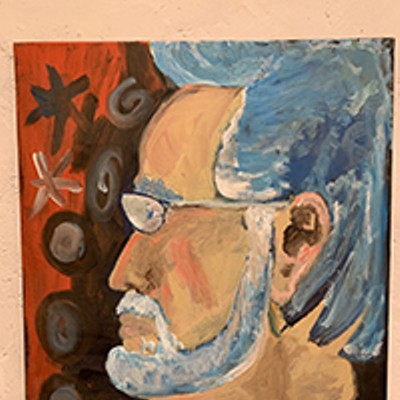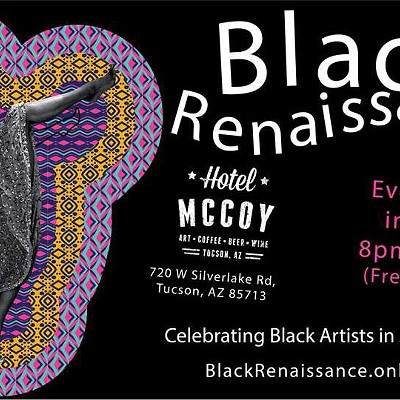"There isn't much green here," she points out, at least not since the drought withered the desert to a pale dusty brown. "I love water. In the Midwest, it's foggy and humid right now. I wish it would rain."
It hasn't rained here since March, and seems unlikely even to sprinkle in the foreseeable future, so Meehan has created her own art raindrops. They'll tumble down the walls of Dinnerware Contemporary Arts Gallery in the big water show, H20, opening this Saturday.
Ironically, the installation lacks real water, just as the parched city does.
"It's all unnatural materials. There's no water in them at all," explains the artist, perhaps best known for her ceiling mural in the Rialto Theatre lobby. She made the drops out of flat magnetic sheet metal, and coated them with such shiny resin that they gleam like the body of a hot-rod car. The 42 glittering raindrops in her art shower, "Hot Rod Hangover," will swell from 2 to 12 inches high.
Meehan says their simple raindrop shape conflates tears and rain. The teardrops represent sadness, she says, but their sorrow has been transformed into this "joyful, hopeful piece." After all, it has to rain sometime.
In the meantime, she adds, "I need somebody to loan me a pool."
Meehan is hardly the only artist in town thinking about water. When Dinnerware put out a call for entries for a juried show of water art, the gallery was deluged with entries. Departing director Sarah Hardesty expects to install 30 to 40 water pieces by as many Tucson artists by opening night.
"For Tucson, in the summer, right before the monsoon, a water show makes sense," says Hardesty, who has the good fortune to be heading to the Atlantic coast for a summer art residency in the seaside town of Gloucester, Mass. "Water is a relevant issue, and we wanted to address it. Plus, we're part of the Art Cruise."
For the last six years, the playfully named Summer Art Cruise has kicked off the season for the Central Tucson Gallery Association. On Saturday night, art lubbers are invited to sail around to seven contemporary art galleries in central Tucson, plus an eighth in Barrio Historico, the new Studio Centella.
Dinnerware's H2O naturally boasts the highest tally of water pieces, but the drought has quite a number of local artists meditating on water, or the lack thereof. Floods, drought, fire, fountains, oceans and boats inundate their pieces. The water artworks range from the relatively realistic--Duncan Martin's "White Light, Green Sea" is a delectably moist oil on linen at Davis Dominguez that conjures up waves crashing in the high seas--to cutting-edge contemporary. Neil Bernstein, for instance, showing at Espresso Art, makes pieces out of found objects, including soaked debris he scavenged in the 9th Ward of New Orleans in the wake of Hurricane Katrina.
Photographer Stu Jenks also ventured far for his liquid imagery, ferrying around the Scottish Hebrides islands last October. In "The Uig Ferry," his colored photo in Dinnerware's H2O, the ship's windows frame a view of an island and the sea. Jenks typically accompanies his visual art with a piece of writing; this one tells the story of a young single mom and her small child on board the ferry, waving goodbye to her parents on shore. The young woman had apparently grown up on the island, but was returning to her new life in the big city.
"It was a very sad moment," Jenks says of the true-life story. "I was not about to take the camera out of the case and take a picture of the mother. But I took a photo of the water and of the distance. The water both separates her from her parents and brings them together. I like dualities," he adds, "two opposing ideas coming together."
Jessica James Lansdon, who made a splash with her Liquidation installation at the Museum of Contemporary Art this spring, also plays around with clashing themes.
"I'm fascinated by the juxtaposition of water against the desert," she says. "I grew up in Tucson, but I grew up around water. We did a lot of boating in the arid regions, in Lake Powell or in Baja. I lived in a swimsuit. Both my parents were lifeguards at one point."
Nowadays, in dry Tucson, "I have almost a fantasy relationship to water. I don't see much of it."
For her H2O installation, still just a sketch at press time, she'll follow her usual procedure of deploying found objects. The work will try to tease out the contradictions inherent in a desert inhabited by water-guzzling humans.
"It will be a collection of objects--toy boats--with string art between them. I'll use hot glue and silicone (for the string). It will be clear, gelatinous and liquid-like." The translucent string, she says, evokes the water shooting out of the sprinklers she remembers from her grandpa's lawn.
At the Gallery at 6th and 6th, Bohdan Osyczka's giant watercolors are not about the sociological or environmental implications of water. They're about the delirious possibilities of water itself, including its ability to saturate, splatter and splash. At Davis Dominguez, James Cook pays homage to the natural beauty of bodies of water; his "Cape Elizabeth" is a dewy oil on linen of waves lapping against rocks. Joanne Kerrihard's "Sirens," an oil painting at the same gallery, captures the shimmering surface of the green sea and the curve of a red boat afloat.
But sculptor Barbara Jo McLaughlin proves the most pragmatic. With the fire season already begun, her "Pumper," at Davis Dominguez, might be grimly prophetic. Made of wood and tubing, it's a fire hose, coiled and waiting, ready to spring into action against the fires that may soon be smoldering in the tinder-dry mountains.














